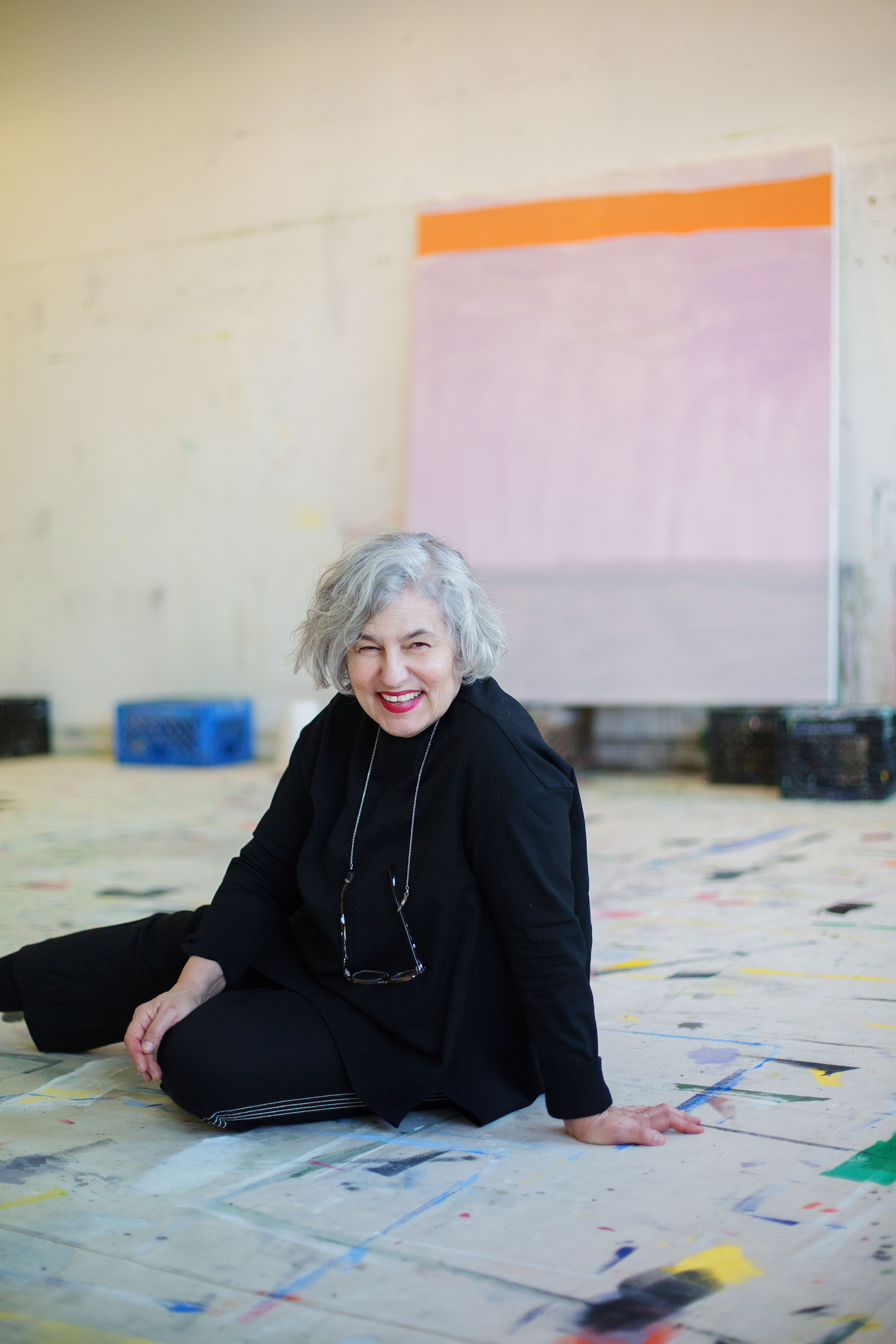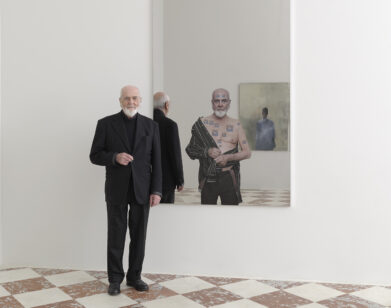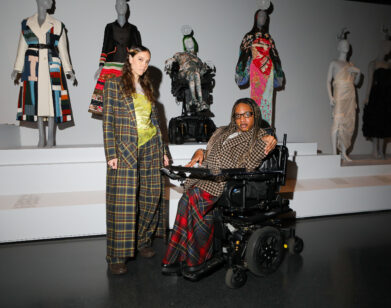The playfully troubled art of Amy Sillman
An astrologist once told artist Amy Sillman she wielded a poisoned pen in her past life, as an angry letter writer. “In this life I was making up for that by being invested in a non-linguistic form,” Sillman says. The 62-year-old has made a career out of visually lush, vividly abstract works: paintings, drawings, paintings that look like drawings, drawings that look like paintings, zines, cartoons, and animations. She’s also a gifted writer, who has managed to write the funniest and most compulsively readable essay about color theory ever. (Sillman says she wouldn’t mind going back to being a writer in a different life.)
Sillman was born in Detroit, studied art in New York, and spent the ’80s and ’90s moving from figuration to abstraction, rambunctiously experimenting with new forms and mediums such as moving images. One major breakthrough came in the early 2000s, when she says a series of personal losses led her to make serious art; another came in 2013 with her first museum survey: “one lump or two,” which opened at the Institute of Contemporary Art in Boston, and traveled the country. Sillman’s paintings—with their barbed humor, their playfulness, their colorful spirit mixed with angst and trouble and dread—are widely seen as reinvigorating abstract expressionism.
Despite the energy and urgency of her work, Sillman is a notorious tinkerer. She sometimes spends weeks or months on a single piece, scratching it up and turning it this way and that. (She says under each painting live 100 others.) In “Mostly Drawing,” her new show at Gladstone Gallery, she experimented with speed: moving quickly through works, abandoning them when they didn’t feel right. She also, for the first time, combined silkscreened, painted, and drawn elements in paper works that aim to fool the eye. They are more than just drawings: up close, a network of layers is revealed, with silkscreened figures and painted brushstrokes in conversation with one another. We spoke recently in her Bushwick studio. In person, Sillman is ebullient and self-deprecating; she seems to radiate the same lovely, weird openness as her art.
MATT MULLEN: Where did this new body of work come from?
AMY SILLMAN: I started thinking, “What if I draw first and print over it?” So I made silk screens of my drawings. I could add a drawing that was made with a machine or digitally to a drawing that was made by hand. What I love is that you can’t tell how they’re made. For some reason, fooling the eye really excites me. Then it got more and more baroque. I started to make these really complicated ones that were totally abstract. I just wanted to see if I could make it literally impossible for someone to tell how it was made, and what was underneath.
I’m in this process of trying to create a free space. Like an open field, where figure and ground are in very ambivalent, complex relationships. On top of that, I also wanted to see if I could try to blurt something out, or make something completely immediate, that ends up fitting perfectly. More recently, I started thinking about shape. I’ve never read a book on shape. I’ve read books on gesture; I’ve read tons of books on color, surface, field, ground, representation, abstraction. But I’ve never read a book on what a shape is. I like shapes. So I was making all of these round ones. And then I thought, “I guess they’re people.”
MULLEN: You worked quickly on this work, is that right?
SILLMAN: Yes! I tried really hard to blow through a lot of layers and a lot of ideas. The silkscreening was amazing, because everything I did, I could wash off. And then have it again. So there was this step and repeat thing, learning a technique where you get a second chance. A lot of what I do in my work is taking a thing and either washing it off, scraping it, covering it, scraping it and then washing it, turning it upside down. Making it somehow blind. Troubling the way of making so that there’s sort of a backwards surprise to be found in the end.
MULLEN: So how do you know when a painting is done?
SILLMAN: That’s just it—you have a gut reaction. But every painting I’ve ever done has like 100 paintings under it. And everyone always says. “Oh, but why didn’t you stop earlier on? It was so good, stop.” At some point, I get a weird feeling, and that’s when I know it’s done. I probably ruin a lot of really perfectly fine things. So part of working on paper, and trying to work really fast, is to see if I can expand the area of not being driven by taste. Not saying, “This looks good, I’ll stop.”
I want to expand the question of when something is done. I want to vex the ending. I want to mess around with that. I like the idea that if you make a work that has no clear ending, then you must play with the ending. Because if you don’t, you’re not highlighting the weird, lovely openness of abstraction. All accidents and experiments, and discoveries, are what my work is about. The problem that I have as an artist is being way too critical.
MULLEN: Self-critical?
SILLMAN: Yeah, I won’t let something just sit there and breathe. I make paintings really slowly because I change them and change them and change them and change them and change them. I don’t really know how to not do that. I’m not very free in a way. Even though it looks free. But it’s not.
MULLEN: Would you say you’re restless with your practice?
SILLMAN: It’s more this instinct to get in trouble, and then get myself out of trouble. That’s what painting is for me. You can make a beautiful thing, but there’s no problem in it. I like the idea of doing a thing, wrecking a thing, questioning a thing to the point where you have pushed it to the edge, and then recuperating it.
MULLEN: What does recuperation look like?
SILLMAN: You just have to find a way. If it doesn’t work, you throw it away. The works have to look like they’re confident. But they also have to look sort of troubled. It’s this weird thing: “Does that look confident and troubled?” It’s a bit like difficult poetry. In my work, we’re not looking at an icon, we’re not looking at a sign, we’re not looking at a representation. We’re looking at something. I do have this feeling of trust that people can read it for themselves.
MULLEN: It’s also this idea of offering more questions than answers.
SILLMAN: Yes! Because then the thing comes out at you. Hopefully, there are people that are interested in going on that ride. We need people who hate painting, because then the painting lovers are more like, “Why do I like it?” It’s terrible, it’s boring, it’s market-driven. It does all the things that the critique says it does. It goes on rich people’s walls, it’s too expensive. It does all this stuff, but then at the same time you look at some paintings and you’re like, “Come on! Is that a commodity? It’s so fucking weird.”
MULLEN: In your essay “On Color,” you asked—sort of as a joke—“What Freudian mistake led me to this place” of being a painter. Do you have an answer to that?
SILLMAN: Bad parenting.
MULLEN: Really?
SILLMAN: Yes.
MULLEN: What was your childhood like?
SILLMAN: Mixed. Who would be an artist that was perfectly happy? Maybe nowadays, but when I grew up in the ’60s, you had nobody in the art club who was popular. No cheerleaders in the art club. I was told that I couldn’t be a painter by my first painting teacher. I said I wanted to go to Cooper and be an art student, and he said, “You’ll be a waitress.” It was really the strangely indifferent parenting. I remember one time I was told not to make a mess in the backyard, so I painted our little gazebo. I took really sticky sky blue enamel paint out of the garage. I painted the fucking lawn. Being bad. Discomfort with your body. Bad self image. All those things turn you into an artist. The same things that keep you from being in a proper marriage.
MULLEN: Do you think that’s reflected in your work?
SILLMAN: I hope so. I hope it beams out to all the other people who didn’t make the varsity team.
“AMY SILLMAN: MOSTLY DRAWING” OPENS JANUARY 26 AT GLADSTONE GALLERY 64 IN NEW YORK.







